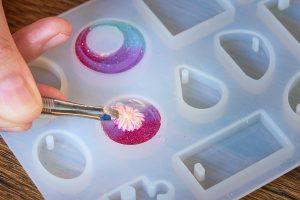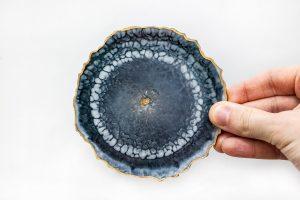How do you feel when your epoxy resin remains sticky even after the curing time is over? For sure, not good.
![How To Harden Sticky Resin [Uncured Epoxy Solutions] The blue coasters is made of epoxy resin. Stand, tray, or decorative element on wooden shelf.](https://homesthetics.net/wp-content/uploads/2022/01/How-to-harden-sticky-resin-1.jpg)
But there’s nothing to worry about, as this problem is more common than you think. People who work with resin often face issues that delay their projects. This happens because of some anomalies in the chemical reaction between the resin and the hardener.
You need to understand that not all problems related to resins are the same. And because of that, they require different solutions. So, in this guide, we will take you through the most common problems that resin users face and tell you how to overcome them. After reading this, we can assure you that you will be better equipped to handle this material.
Without any further delay, let’s dive right in!
How To Harden Sticky Resin

-
Dealing With Runny Resin
When working with resin, you might be in a situation where the resin looks uncured even after you give it the required curing time. In fact, it might remain a little gooey even after drying for an entire day. And there can be multiple reasons behind this.
For example, if you end up mixing more colorant than required while preparing the resin, then chances are that it will have a hard time solidifying. To give you an estimate, it is best to mix around 5-6 % colorant of the total amount of the hardener and resin.
Moreover, we have come across people making the mistake of adding two hardeners to resin. But it’s always better to add one, as otherwise, the outcome might remain gooey.
And the most common mistake that people commit is that they do not keep the proportion of the hardener and the resin right. That’s why we’d strongly recommend reading the mixing instructions thoroughly beforehand. In case you face any difficulty in understanding, you can contact the seller to resolve any queries.
How To Fix It?
If you are trying to fix runny resin, the most important thing to do is to scrape it off the surface. This is an essential step, and unless you do it correctly, then chances are that it will start leaking the moment you apply a fresh coat.
After you are done taking it off, apply a fresh coat. But make sure that you keep the proportions correct and apply them following all the instructions. Unless you do that, the resin layer will turn out runny again, and you would have to redo the entire process.

-
Problem Of Soft Spots
Once the resin is cured, you might be surprised to find a few stubborn spots that refuse to get dried. This leaves a few patches that remain wet for a long time. There is no pattern to soft spots, and they can appear anywhere.
It mainly happens when you fail to mix the hardener with the resin thoroughly. Or, you may even face this problem if the hardener gets stuck to the sides. So, we would recommend that you scrape the sides well when you are mixing and pouring. Without proper mixing, soft spots are highly likely to appear once the resin starts to dry.
How To Fix It?
In order to fix this issue, you would need to get hold of an 80-grit sanding paper. With this, you can sand it and clean off the dust from the surface. While sanding it, if you find specific parts to be gooey, do your best to remove them.
And only when you are sure that there is no more runny resin left on the surface can you start pouring a fresh batch.

-
Difficulty In Hardening Sticky Resin
Sometimes you will find the resin to remain a little sticky even after mixing a hardener in it. In situations like this, the resin hardens but still remains a little sticky. What do you do in such a situation?
This may happen because of multiple reasons. Many people are impatient and do not mix the resin well before they start with the work. We would recommend that you mix at least for a good 3-5 minutes.
This way, the resin and the hardener will mix adequately, and there will be no lumps in the mixture. And while you are at it, scrape the sides and the corners too to ensure that there are no lumps.
Other than that, you need to stay very cautious about the resin to hardener ratio. Read the instructions very carefully or watch some tutorial videos on the internet for help. Unless you keep the ratio right, the chances are that the resin will remain a little sticky.
We have also seen that resin tends to be a bit gooey and sticky when the ambient temperature of your workshop is not correct. If it is too high or too low, the resin will not be able to harden properly. For the first day of curing, ensure that the temperature is between 75 and 85 degrees Fahrenheit.
How To Fix It?
Unlike all the problems that we have discussed so far, this one is relatively easy to fix. In case you see that the resin is still sticky even after the curing time, you need to make a fresh batch and then pour it over the existing surface.
After doing this, give it the proper time to cure. If you have already identified a problem with the previous batch, make sure that you do not repeat the same mistake. Sometimes the temperature is an issue. If the ambient temperature was too low the previous time, ensure that you move it to a warmer place.
Apart from pouring a fresh layer, you can also try wet sanding the first layer. We would suggest that you continue to sand until you reach a solid surface. Once you are done sanding, you can pour a new layer.
And this time, do not forget to use a resin or acrylic-based sealer to make sure that the surface layer is effectively sealed.

Tricks To Harden Sticky Resin Easily
If you are new to working with resin, the chances are that you are not too familiar with the medium. When that’s the case, you will likely face a lot of problems. In this section, we will throw light on some of the things that you can do to avoid these problems.
-
Get Acquainted With The Instructions
Whether you are new to working with resin or not, always make sure that you do not miss out on the instructions. Resins of different brands work differently, and you must keep yourself well-versed with their functioning.
Moreover, in case you plan on working on a big project, we would recommend that you do a test round first. This will help you get acquainted with the resin better and reduce your chances of committing mistakes.
-
Learn How To Handle Sticky Resin
Handling sticky resin is not an easy thing to do, and to make your job easy, you can consider using Modge Podge. All you have to do is cover the sticky parts and leave them to dry. Other than that, you can also use triple-thick polyurethane.
Even after a day’s time, if you still find the resin to be a little sticky, just spray the surface with this. Then let it sit for 40 minutes before coating it again with another layer.
-
Pay Attention To Detail
In order to avoid resin-related problems, it is essential that you understand the material well. We would recommend that you choose to work in warmer areas as cold temperatures tend to delay the curing process.
And when mixing the resin, hardener, and color, make sure that you mix it well and there are no lumps or air bubbles present in the mixture. You need to be more careful if you are mixing colors to the mix and take proper care to mix them in the correct ratio.

Final Words
On that note, we have come to the end of this comprehensive guide.
We hope you have learnt a thing or two about hardening sticky resins and will be able to handle the material better. Before you start working, it is essential that you understand the basics in order to not commit the mistakes that we have discussed.
However, even after being careful, sometimes the resins do not act as they should. They do not cure properly and leave your project in a mess. But once you apply the techniques that we have discussed in this guide, we are sure you will be able to fix the problems in no time.
In case you have any further doubts, feel free to reach out to us in the comments section below. And keep a watch on this space for more compelling reads.
Until next time, fare thee well!
Related Articles
What is Resin and How It’s Used
Alcohol Ink and Epoxy Resin 101
5 Best Epoxy Resin for Tumblers
11 Best Epoxy Resin For Crafts
The Difference Between Epoxy & Super Glue
Waterproof Epoxy 101 [Is Epoxy Waterproof?]
10 Best Epoxy for Plastic Today
How to Color Clear Epoxy Resin [Coloring Resin
How To Fix Radiator Leak With Epoxy+ Best Radiator Repair Epoxy
Epoxy Garage Floor 101 [All You Need to Know]
Mold Release Guide + Best Epoxy Release Agents
Surfaces Resin Won’t Stick to [All You Need to Know]
Heat Resistant Epoxy 101 [A Guide for High Temperatures]
Epoxy Cement Guide 101 [How to Repair Concrete with Epoxy]
How To Mix Epoxy 101 [Measuring & Mixing Epoxy Resin Guide]
